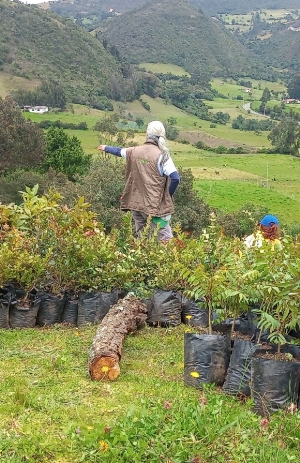URGENT MESSAGE!
Just over 10 years is the time humanity has left to make up for its climate impact.
One of the factors that most influence this crisis are the carbon dioxide emissions emitted into the atmosphere, these are heating up the planet at record levels, and have triggered alterations in the ecosystems... if we do not act quickly, according to the science, may be the beginning of human extinction. It's not a game, the climate crisis is real.
Don't let global warming destroy us, save the planet and act now.
The term "Carbon Footprint" refers to the sum of greenhouse gases that are emitted into the atmosphere as a result of human activity. These emissions can be quantified at different levels or approaches, whether at the country, city, company or even individual level.

What is carbon footprint?
The term "Carbon Footprint" refers to the sum of greenhouse gases that are emitted into the atmosphere as a result of human activity. These emissions can be quantified at different levels or approaches, whether at the country, city, company or even individual level.
How to mitigate the carbon footprint?
Planting native trees, since this way, the carbon footprint that you generate in your daily activities is offset. This is because the trees capture CO₂ from the atmosphere and produce Oxygen.
We invite you to reduce your carbon footprint with basic actions such as:
Reduce your consumption of plastic, always carry water in a bottle.
Take showers of only 5 minutes.
Reduce the consumption of animal protein to the maximum.
Using means of transport with low or zero emissions, such as bicycles, electric vehicles or even walking.
Don't forget to plant trees.

Data in USA
The country's total emissions in 2012 were 258.8 Mton CO2 equivalent. In turn, the absorptions (carbon capture) were -73.2 Mton CO2eq. Thus, net emissions were 185.6 Mton CO2eq.
Colombia's per capita emissions are 4.2 tons CO2eq per inhabitant year, ranking 105th in global GHG emitters per capita.
According to a 2016 IDEAM study, the sectors that generated the most emissions into the atmosphere were forestry and transportation. The main source of emissions from the forestry sector was deforestation due to the conversion of natural forests to pastures, shrublands and secondary vegetation. The main source of emissions from the transport sector was the burning of fossil fuels.
CO2 is the GHG with the highest emission and represents 73.98% of the country's total emissions. CH4, in turn, is the second most emitted GHG with 16.99% of total emissions. The main source of CO2 emissions is deforestation. The main source of CH4 emissions is enteric fermentation (gases from digestion) of cattle.
Frequent questions
How do I find out my gas consumption?
Our Gas consumption is quantified in cubic meters (m3), for this reason, in the Natural Gas bill that we receive on a monthly basis we can find a bar graph. On each bar we will see a number that corresponds to the amount of cubic meters used each month, thus, we can search the graph for the bar corresponding to the month that is being charged on that bill and the number on that bar will correspond to the m3 of gas spent during that month.
How do I find out my gasoline consumption?
To know our gasoline consumption we must be very aware of how much gasoline we tank in our car and from that moment, how many kilometers we travel before the gasoline runs out. Once you have these data, we divide the amount of gasoline tanked by the kilometers traveled and in this way we will know how much gasoline per kilometer traveled our car consumes.
How do I find out my electricity usage?
As with gas, the electricity consumption of our home can be seen in the monthly bill we receive, however, light is not quantified in m3 like gas, it is quantified in kWh (Kilowatts). Taking the above into account, on the electricity bill we will also find a bar graph each bar at the top has a number that corresponds to the amount of kWh consumed that month.
What can I do to mitigate the impact of my carbon footprint?
There are many ways to reduce the carbon footprint generated by our daily activities. Here are 5 ways you can contribute:
➔ Plant trees: The most effective way to mitigate our greenhouse gas emissions is by generating new CO2 sinks (sinks are understood to be all organisms that absorb greenhouse gases, reducing their concentrations in the atmosphere, an action they perform very efficiently trees, since they absorb GHGs and use them in their internal processes while returning oxygen to the atmosphere). However, it is not only about planting trees, it is about planting native species that correspond to these ecosystems in places that have been degraded and that in turn allow us to recover the other ecosystem services that forests offer us.
➔ Use your bike more and your car less: Cars (especially those that run on fossil fuels) emit considerable amounts of polluting gases into the atmosphere that accumulate in the atmosphere and accentuate the greenhouse effect. Bicycles, on the other hand, do not emit any type of polluting gas. and it is also a beneficial activity for your health.
➔ Use reusable cloth bags for shopping: Plastic bags take a long time to biodegrade and in this process they emit polluting gases into the atmosphere, not to mention that they in turn accumulate in dumps, bodies of water and other areas, generating all kinds of environmental impacts.
➔ Reduce meat consumption: The industrial processes for the production of meat, the vast majority of times are not friendly to the environment and are very significant sources of greenhouse gas emissions. For this reason, consuming less meat and replacing it with foods whose production chains are more sustainable is a great option to reduce our emissions.
➔ Recycle, Reuse, Reduce: Better known as the three R's, they are a great way to be more aware of our consumption habits and how we manage our waste, which are major sources of GHG emissions.






 Fundación
Fundación